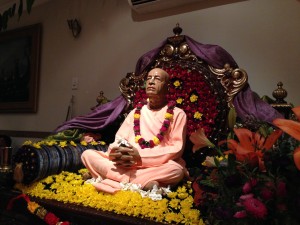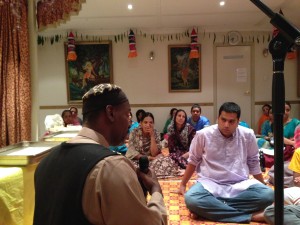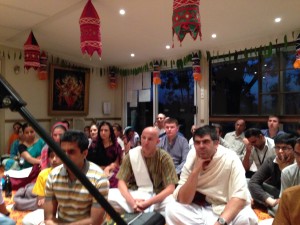
Gopal’s Garden Home School Co-op began its seventh year this September. Two new students joined us from the Philippines and we are very happy to have them as part of our class. Every morning we begin our day at 9:30 with chanting Hare Krsna and Bhagavad-gita verses. The students hear stories about Krsna and the philosophy of Krsna Consciousness. The rest of the morning is devoted to writing and reading. After lunch and recess, we spend the afternoon studying history, science and math.
* * *
Compassionate Communication Class With Sukhavaha
Gerald the Giraffe – by Brinda Turner
Mother Sukhavaha has been doing a weekly class with the students of Gopal’s Garden. She has been talking about compassionate speaking feelings, and emotional boundaries. The class now has its very own Gerald the giraffe puppet because a giraffe has the biggest heart on the planet. Gerald is there to help the children learn to speak nicely and use compassionate communication. When they feel troubled they simply come to Gerald for help. Mother Sukhavaha has been teaching the children how to talk about what they are feeling and why they are feeling that way. The class has worked together to create a list of agreements to help them act and speak compassionately. The students have not had many sessions but it is already helping to transform the classroom.
* * *
Trip To Varsana Swami’s Temple
The Lucky Day by Brinda Turner and Shemaella Rivera
On the morning of Radhastami, we painted wooden frames and decorated them using stencils. At the time we wondered what picture to put inside the frames. Later in the morning we piled in the car and hurried to Varsana Swami’s temple. Although it had been raining really hard, as soon as we arrived the rain turned into a light sprinkling. Taking off our shoes, we entered the temple where Varsana Maharaja gave us a picture of his deities – a perfect picture to place inside the newly decorated frames. When we returned to the class, we decided to put the beautiful framed pictures on the altar. The frames looked beautiful! We were so lucky and blessed to have found the perfect picture.
* * *

Art Class With Krsna Bhava
Learning to Draw What They See
By Ruci DD
Every Tuesday morning the students enter the classroom enthusiastic and ready to draw and paint with Krsna Bhava. This school year they have studied color theory, three dimensional art, and how to recognize the simple shapes and lines in objects in order to draw what they see. In creating their art the students have used acrylic paints, oil pastels, pencils, and markers. Krsna Bhava has been teaching art at Gopal’s Garden for seven years. Her ability to teach and inspire basic art concepts can be seen in her students completed projects (attached) as well as the year-end class project where the students publish their art and writing.
* * *
Student Writing Project With Sankirtana das
By Ruci DD
Sankirtana comes in once a week and has started the school year reading and writing poetry. He is introducing the students to the poetic elements of imagery (‘painting a picture with words’), use of strong words and the way words sound together, expression of feelings, and trying to show that poems are often about common, every day things and moments in life. He starts with role modeling by writing a poem on the spot and helping them write a collective poem which he puts on the blackboard. Then they settle in to write their individual poems. The kids take turns in reading their poems as Sankirtana offers encouragement and constructive criticism.

Poems by Students
Awesome – by Josh Fintel
I’m a fun guy
right after a day of school.
I bring my friends
to the school playground.
We bring our water guns and balloons.
We soak each other to be cool.
I see a red, orange, and green leaf pile move.
I throw a water balloon.
It ends with a splash.
The leaves slide down and my friend starts to laugh.
Living In This Moment – Brinda Turner
Although the leaves are falling
And it is almost Monday
I try to concentrate on this moment
I don’t let myself think
About by feet pounding
Down the hallway to our classroom
I try not to think that it is
Almost winter
I laugh as I fly into the air
Then giggle as I fall back
To the floor of the bouncy house
I am having fun right now
And that is all that matters
As I live in this moment
Not worrying about tomorrow
Poem About Writing
Writing – Josh Fintel
Writing is fun
Writing is story making
Making stories is easy & hard
But stories are entertainment
And learning
I’m an entertainment story guy
Poem About Art
Art – Shemaella Rivera
Since I was a young kid
I wanted to draw something
I kept on thinking how to draw
Painting, drawing, coloring –
The rainbow that makes
My heart happy!

Poems About Math
Math – Josh Fintel
Math is good
Math is food for my brain
Math can be easy like 1 – 1
And math can be hard like 35 x 52
But for me it’s just right
Math – Shemaella Rivera
I don’t care if it’s hard
I don’t care if it’s easy
I’ll just do my best
I’m not gonna give up
Till I get it

Reading – Shemaella Rivera
Peace and quiet
Inside the classroom
You can read
Whatever you love or like
But you can’t read nothing
Come on ! Show me what you’re reading!

Lost in a World of My Own – by Brinda Turner
As soon as I pick up a book
I get sucked in
I despair at difficult situations
Laugh at the funny parts
And sometimes even cry
I forget where I am
About the people around me
All I think about is my book
It is beautiful to see
The words on the page
As they make an image in my
mind
I see every detail
I love the feel of a new book
The crisp white pages just begging to be read
And when the book ends
I reach for another
It amazes the people around me
But to me it is natural
Completely normal
I can read books so thick
My hands can’t even fit around them
In one day without rushing at all
It offers me another world
And that is why reading
Is so important to me
If I have a bad day
I can pick up a book
And forget why I was even upset
I can get lost in a world
Where anything can happen
Anything at all


 Kadamba Kanana Swami is currently in Sri Dham Mayapur! On Sunday,17 November 2013, which is also the last day of the month of Kartik, Maharaja will be giving the morning Srimad Bhagavatam class at the temple.
Kadamba Kanana Swami is currently in Sri Dham Mayapur! On Sunday,17 November 2013, which is also the last day of the month of Kartik, Maharaja will be giving the morning Srimad Bhagavatam class at the temple.






 Locana Das: During the final months last year when my daughter was battling the cancer His Holiness Bir Krishna Maharaja would come every day to our home to read the Krishna Book to her and sing bhajanas
Locana Das: During the final months last year when my daughter was battling the cancer His Holiness Bir Krishna Maharaja would come every day to our home to read the Krishna Book to her and sing bhajanas  The Story of Muni Cari, a devotee who suffered a serious car accident. A short documentary by Leigha Speirs-Hutton, Catherine Moreau-Hammond, Marah Roque and Tom MacGregor.
The Story of Muni Cari, a devotee who suffered a serious car accident. A short documentary by Leigha Speirs-Hutton, Catherine Moreau-Hammond, Marah Roque and Tom MacGregor.  On the last Ekadasi of Kartika, we did all night kirtan at Vrinda Kunda. Then next day celebrated the Marriage of Tulasi and Shalagram. First there are some pics when HH Romapada Maharaja and his disciples visited Vrinda Kunda the day before Ekadasi
On the last Ekadasi of Kartika, we did all night kirtan at Vrinda Kunda. Then next day celebrated the Marriage of Tulasi and Shalagram. First there are some pics when HH Romapada Maharaja and his disciples visited Vrinda Kunda the day before Ekadasi  According to a report from ISKCON Philippines Communications Director Sridama Das, ISKCON devotees in the Philippines remain safe and unharmed in the wake of Typhoon Haiyan, and are planning relief efforts to aid the less fortunate. ISKCON’s main temples in the Philippines -- the Sri Sri Madhava Mandir located at Makati City in Metro Manila, and the New Navadvip Eco Village in Alaminos, Laguna, were spared any major damage, however.
According to a report from ISKCON Philippines Communications Director Sridama Das, ISKCON devotees in the Philippines remain safe and unharmed in the wake of Typhoon Haiyan, and are planning relief efforts to aid the less fortunate. ISKCON’s main temples in the Philippines -- the Sri Sri Madhava Mandir located at Makati City in Metro Manila, and the New Navadvip Eco Village in Alaminos, Laguna, were spared any major damage, however. 








